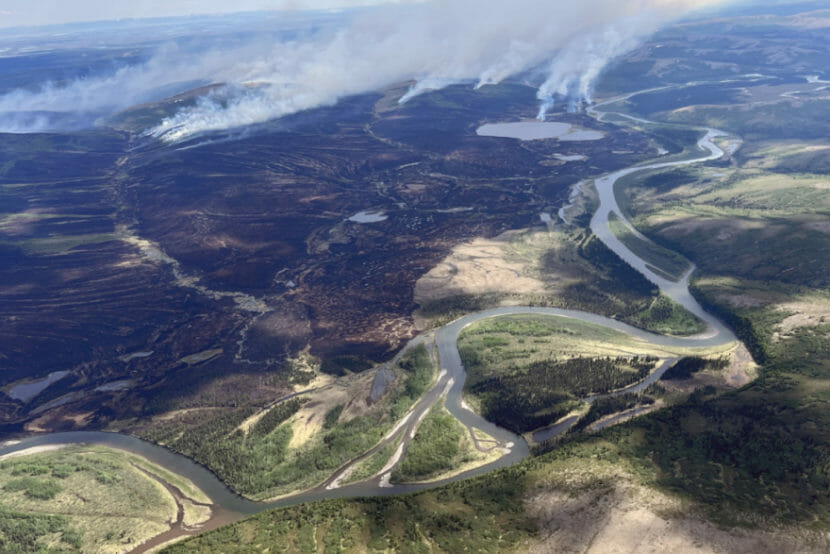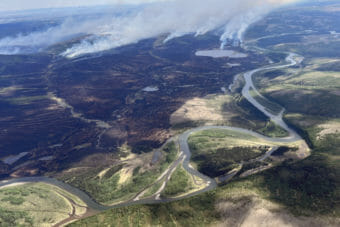
Updated June 10, 7:17 a.m.
Two communities along the lower Yukon River have begun evacuating their most vulnerable residents from a tundra fire.
By Thursday the tundra fire was burning less than 8 miles from St. Mary’s, population 599, and Pitkas Point, population 120. Wind was spreading the fire closer to the villages.
The City of St. Mary’s and its two tribes, the Yupiit of Andreakfsiy and the Algaaciq Tribe, held a community meeting on June 9. There, resident Geraldine Beans said that community leaders chose an optional evacuation for elders and people who are considered vulnerable. Other residents will have to wait
The fire is the largest in the history of the Lower Yukon valley. It’s been burning for a week and a half, since May 31, and has grown to about 50,000 acres.
Beans has lived in St. Mary’s her whole life. This is the first time she’s ever heard about the village being evacuated due to a tundra fire.
“Right now, I can look out my bedroom window and just see the smoke billowing up. Like, right over here on the horizon,” Beans said.
Beans said that she and her family won’t be evacuating just yet, even though her husband is technically an elder. At 68, she said that he’s still active. But she said that the wind is picking up, which is not good news for the community. She said that if the fire reaches the village, her family and others will leave by boat.
“We noticed a lot of people today getting their boats ready, getting gas. And bringing tents, and sleeping bags, and water, and stuff down to their boats so they’ll be ready to go out to a safer spot,” she said.
Beans said that for now, though, she and her family are holding out.
“We’re doing good right now, and so far we’re not in panic mode,” she said.
The Bureau of Land Management sent 51 firefighters to contain the fire. But spokesperson Beth Ipsen says they have not been able to prevent the flames from spreading closer to the community.
“We’re in a defensive posture, because really, unless there’s a significant change in weather there, it’s going to take a lot to stop that fire,” Ipsen said.
Jeremy Zidek is the spokesperson for the Alaska Division of Homeland Security and Emergency Management. He said workers at the Yukon-Kuskokwim Health Corporation Sub-Regional Clinic in St. Mary’s are creating a list of people who the clinic considers vulnerable and is calling them, asking if they want to evacuate. He said in most instances the state defers to local leaders to declare evacuation orders.
As of 3 p.m. Thursday, all Yute Commuter Service flights across the region were canceled. Yute instead sent all its planes to St. Mary’s to evacuate residents.
Children, elders and vulnerable people were evacuated first. About 60 people arrived in Bethel on Thursday night and were being housed at the National Guard Armory.
Another regional airline, Grant Aviation, is on deck to also provide planes for evacuation if needed. Director of Operations Dan Knesek said that the Yukon-Kuskokwim Health Corporation will let the airline know if more support is needed.
Smaller fires are also burning in other parts of Southwest Alaska. There are several in the Bristol Bay region. And a tundra fire between the coastal communities of Tununak and Toksook Bay seems to be contained for now, but wind could spread the fire closer to the communities.
This fire has been burning for three days and has grown to at least 30 acres. According to state Division of Forestry, it spread within five miles of the communities of Tununak and Toksook Bay, and within a half mile of power lines that serve the villages. That day, Wednesday, the Division deployed a plane and a dozen smokejumpers to contain the fire.
Ari Lightley is a spokesperson with the Division.
“Firefighters were able to get around the fire last night [June 8] and secure the fire’s perimeter, and it’s looking pretty windy there, so they’re just working on making sure that perimeter stays secure,” he said.
The fire crew recorded 15 to 20 mile per hour winds. The smokejumpers are remaining on the scene to monitor the fire and respond to any changes.
The fire growth today [June 9] will all be determined by wind, and if they’re able to keep the containment lines secure, Lightley said.
Toksook Bay Search and Rescue Coordinator Harry Tulik says as of Thursday morning, [June 9] he no longer saw smoke rising from the tundra.
All of these fires were ignited by lightning. But University of Alaska Fairbanks Climate Specialist Rick Thoman said what caused them to grow so large were abnormally warm and dry weather patterns consistent with a warming climate.
“It is worrisome,” he said.
Ipsen with BLM says she hopes this weekend’s forecasted cooler temperatures will help slow the current fires. But she acknowledges that the wind is doing the most to help the fire spread, and that’s not expected to slow.
Thoman said there’s one thing needed to really stop the fires.
“What we really need, though, across southwest Alaska is a nice Bering Sea storm to come in and produce, you know, a couple of days of cloudy, cool, wet weather. And that is not on the horizon,” he said.
This story and headline have been updated to reflect that evacuations have started, and more information was added about fire conditions in the region.

